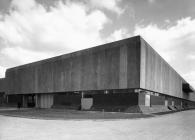The Royal Mint
Items in this story:
The Royal Mint in Wales
The Royal Mint at Llantrisant was opened officially by the Queen on 17 December 1968, when the first press was started to prepare for the change to decimal currency in Britain.
But did you know that the Mint was nearly built in the Pyle area of Bridgend?
Although discussions began in 1959 concerning moving the Mint from Tower Hill in London to a place where expansion would not be a problem, Llantrisant was not considered seriously until February 1967! Before then, Pyle, Bridgend was the favourite proposed site in Wales! Llantrisant was fourth on the government's favourites list, after Runcorn in Cheshire, Washington, Tyne and Wear, and Cumbernauld in north Lanarkshire in Scotland.
Decimal Currency
The government decided in 1966 that the country would begin using decimal currency in February 1971, and because of that the Mint in Tower Hill came under threat. Production there had risen annually, and had risen 46 per cent between 1953/4 and 1960/1, though it had been noted that the site was too small as far back as the beginning of the 50s. It was impossible for them to produce the new decimal coins, especially as the site at Tower Hill is urban, and it was not possible to expand the site there.
It was announced in April 1967 that Llantrisant would be the site of the new Royal Mint, and construction began. In December the same year, the first royal coins were produced on Welsh soil, in Bridgend, to train new members of staff to mint as the new buildings were being constructed. By the end of 1968 over 200 people were receiving training in Bridgend and had produced around 296.8 million coins.
Opening and Expansion
James Callaghan, the Home Secretary, laid the foundation stone on 19 February 1968, and the first coin was produced on the site by the Queen on 17 December the same year. By August, the expected teething problems had been resolved, and Llantrisant reached its target of 50 million coins per week. In October a record was broken when 58 million coins were produced in a week. By the end of the year, Llantrisant had passed its original target and had produced more than 300 thousand extra coins.
Though the target was reached in 1969, Llantrisant was not a complete Mint. They did not have the space for smelting, rolling or producing blanks, so they were buying blank pennies from three places: the Mint in Birmingham, Imperial Metal Industries Ltd., and the Royal Ordnance Factory. But in order for the work at Llantrisant to complement the work at Tower Hill, it was decided to expand Llantrisant. The last penny, a gold sovereign, was produced at Tower Hill in November 1975, and since then all of Britain's coinage has been produced in Llantrisant.
The Royal Mint Today
Today the Royal Mint in Llantrisant employs over 700 people, and works 24 hours a day, 52 weeks a year. They produce 90 million coins a week, which is almost 5 billion coins a year, and they are a very big exporter. The Mint produces coins and medals for 60 countries apart from Britain.
As well as coins, the Royal Mint would produce around 4,700 gold, silver and bronze medals for the London 2012 Olympic and Paralympic Games.



